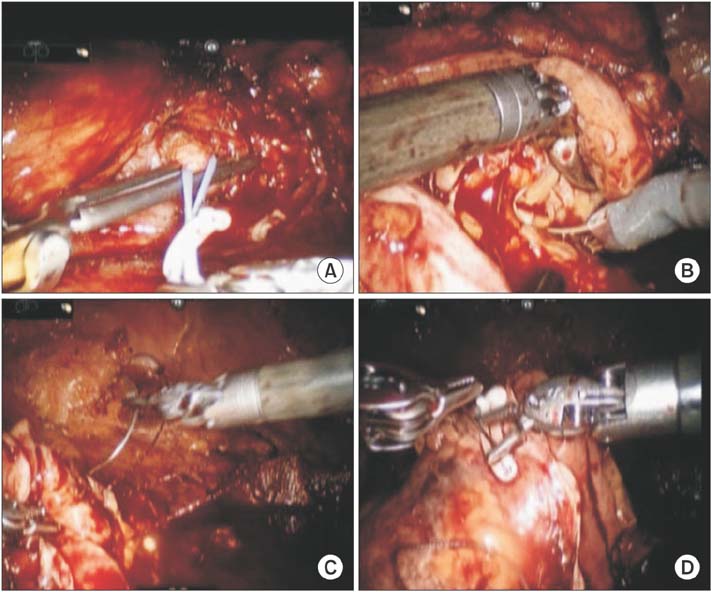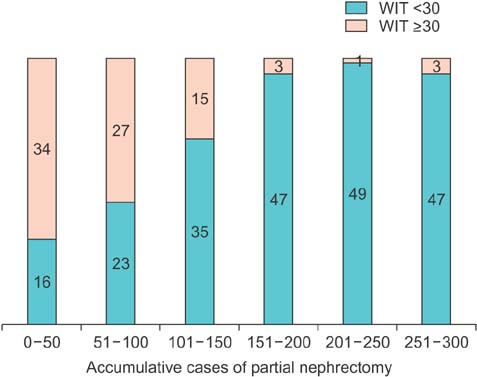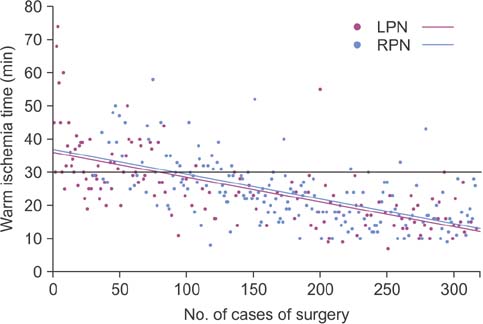Korean J Urol.
2015 Nov;56(11):742-748. 10.4111/kju.2015.56.11.742.
Predictive factors of prolonged warm ischemic time (> or =30 minutes) during partial nephrectomy under pneumoperitoneum
- Affiliations
-
- 1Department of Urology, Samsung Medical Center, Sungkyunkwan University School of Medicine, Seoul, Korea. siseo@skku.edu
- 2Department of Urology, Hallym University Kangnam Sacred Heart Hospital, Hallym University College of Medicine, Seoul, Korea.
- KMID: 2351036
- DOI: http://doi.org/10.4111/kju.2015.56.11.742
Abstract
- PURPOSE
Current clinical data support a safe warm ischemia time (WIT) limit of 30 minutes during laparoscopic partial nephrectomy (LPN) or robot-assisted partial nephrectomy (RPN). We evaluated independent factors predicting prolonged WIT (more than 30 minutes) after LPN or RPN.
MATERIALS AND METHODS
A retrospective data review was performed for 317 consecutive patients who underwent LPN or RPN performed by the same surgeon from October 2007 to May 2013. Patients were divided into two groups: group A was defined as prolonged WIT (> or =30 minutes) and group B as short WIT (<30 minutes). We compared clinical factors between the two groups to evaluate predictors of prolonged WIT.
RESULTS
Among 317 consecutive patients, 80 were in the prolonged WIT group. Baseline characteristics were not significantly different between the groups. In the univariable analysis, PADUA (preoperative aspects and dimensions used for an anatomical) score (p=0.001), approach method (transperitoneal or retroperitoneal approach; p<0.001), and surgeon experience (p<0.001) were significantly associated with prolonged WIT. In the multivariable analysis, PADUA score (p=0.032), tumor size (> or =25 mm; odds ratio, 2.98; 95% confidence interval, 1.48-5.96; p=0.002), and surgeon experience (p<0.001) were independent predictors of prolonged WIT.
CONCLUSIONS
Surgeon experience, tumor size, and PADUA score predicted prolonged WIT after RPN or LPN. Among these factors, increasing surgical experience with LPN or RPN is the most important factor for preventing prolonged WIT.
MeSH Terms
-
Adult
Aged
Carcinoma, Renal Cell/pathology/*surgery
Clinical Competence
Female
Humans
Intraoperative Period
Kidney Neoplasms/pathology/*surgery
Laparoscopy/methods
Male
Middle Aged
Nephrectomy/*methods
Pneumoperitoneum, Artificial/*methods
Retrospective Studies
Risk Factors
Robotic Surgical Procedures/methods
Warm Ischemia/*methods
Figure
Reference
-
1. Jemal A, Bray F, Center MM, Ferlay J, Ward E, Forman D. Global cancer statistics. CA Cancer J Clin. 2011; 61:69–90.2. Patard JJ, Shvarts O, Lam JS, Pantuck AJ, Kim HL, Ficarra V, et al. Safety and efficacy of partial nephrectomy for all T1 tumors based on an international multicenter experience. J Urol. 2004; 171(6 Pt 1):2181–2185.3. Benway BM, Bhayani SB, Rogers CG, Dulabon LM, Patel MN, Lipkin M, et al. Robot assisted partial nephrectomy versus laparoscopic partial nephrectomy for renal tumors: a multi-institutional analysis of perioperative outcomes. J Urol. 2009; 182:866–872.4. Lane BR, Babineau DC, Poggio ED, Weight CJ, Larson BT, Gill IS, et al. Factors predicting renal functional outcome after partial nephrectomy. J Urol. 2008; 180:2363–2368.5. Becker F, Van Poppel H, Hakenberg OW, Stief C, Gill I, Guazzoni G, et al. Assessing the impact of ischaemia time during partial nephrectomy. Eur Urol. 2009; 56:625–634.6. Godoy G, Ramanathan V, Kanofsky JA, O'Malley RL, Tareen BU, Taneja SS, et al. Effect of warm ischemia time during laparoscopic partial nephrectomy on early postoperative glomerular filtration rate. J Urol. 2009; 181:2438–2443.7. Choi JD, Park JW, Choi JY, Kim HS, Jeong BC, Jeon SS, et al. Renal damage caused by warm ischaemia during laparoscopic and robot-assisted partial nephrectomy: an assessment using Tc 99m-DTPA glomerular filtration rate. Eur Urol. 2010; 58:900–905.8. Campbell SC, Novick AC, Belldegrun A, Blute ML, Chow GK, Derweesh IH, et al. Guideline for management of the clinical T1 renal mass. J Urol. 2009; 182:1271–1279.9. Roos FC, Brenner W, Muller M, Schubert C, Jager WJ, Thuroff JW, et al. Oncologic long-term outcome of elective nephronsparing surgery versus radical nephrectomy in patients with renal cell carcinoma stage pT1b or greater in a matched-pair cohort. Urology. 2011; 77:803–808.10. Sprenkle PC, Power N, Ghoneim T, Touijer KA, Dalbagni G, Russo P, et al. Comparison of open and minimally invasive partial nephrectomy for renal tumors 4-7 centimeters. Eur Urol. 2012; 61:593–599.11. Hayn MH, Schwaab T, Underwood W, Kim HL. RENAL nephrometry score predicts surgical outcomes of laparoscopic partial nephrectomy. BJU Int. 2011; 108:876–881.12. Ficarra V, Bhayani S, Porter J, Buffi N, Lee R, Cestari A, et al. Predictors of warm ischemia time and perioperative complications in a multicenter, international series of robot-assisted partial nephrectomy. Eur Urol. 2012; 61:395–402.13. Wang L, Wu Z, Ye H, Li M, Sheng J, Liu B, et al. Correlations of tumor size, RENAL, centrality index, preoperative aspects and dimensions used for anatomical, and diameter-axial-polar scoring with warm ischemia time in a single surgeon's series of robotic partial nephrectomy. Urology. 2014; 83:1075–1079.14. Mottrie A, De Naeyer G, Schatteman P, Carpentier P, Sangalli M, Ficarra V. Impact of the learning curve on perioperative outcomes in patients who underwent robotic partial nephrectomy for parenchymal renal tumours. Eur Urol. 2010; 58:127–132.15. Aboumarzouk OM, Stein RJ, Eyraud R, Haber GP, Chlosta PL, Somani BK, et al. Robotic versus laparoscopic partial nephrectomy: a systematic review and meta-analysis. Eur Urol. 2012; 62:1023–1033.16. Zargar H, Bhayani S, Allaf ME, Stifelman M, Rogers C, Larson J, et al. Comparison of perioperative outcomes of robot-assisted partial nephrectomy and open partial nephrectomy in patients with a solitary kidney. J Endourol. 2014; 28:1224–1230.
- Full Text Links
- Actions
-
Cited
- CITED
-
- Close
- Share
- Similar articles
-
- Feasibility of Laparoendoscopic Single-Site Partial Nephrectomy in a Porcine Model
- Analysis of Surgical Results of Laparoscopic Partial Nephrectomy for Endophytic Renal Tumor
- Current Status of Partial Nephrectomy for Renal Mass
- Operative Outcomes of Robotic Partial Nephrectomy: A Comparison with Conventional Laparoscopic Partial Nephrectomy
- The Impact of Using a Porcine Model in Laparoscopic Partial Nephrectomy Training




